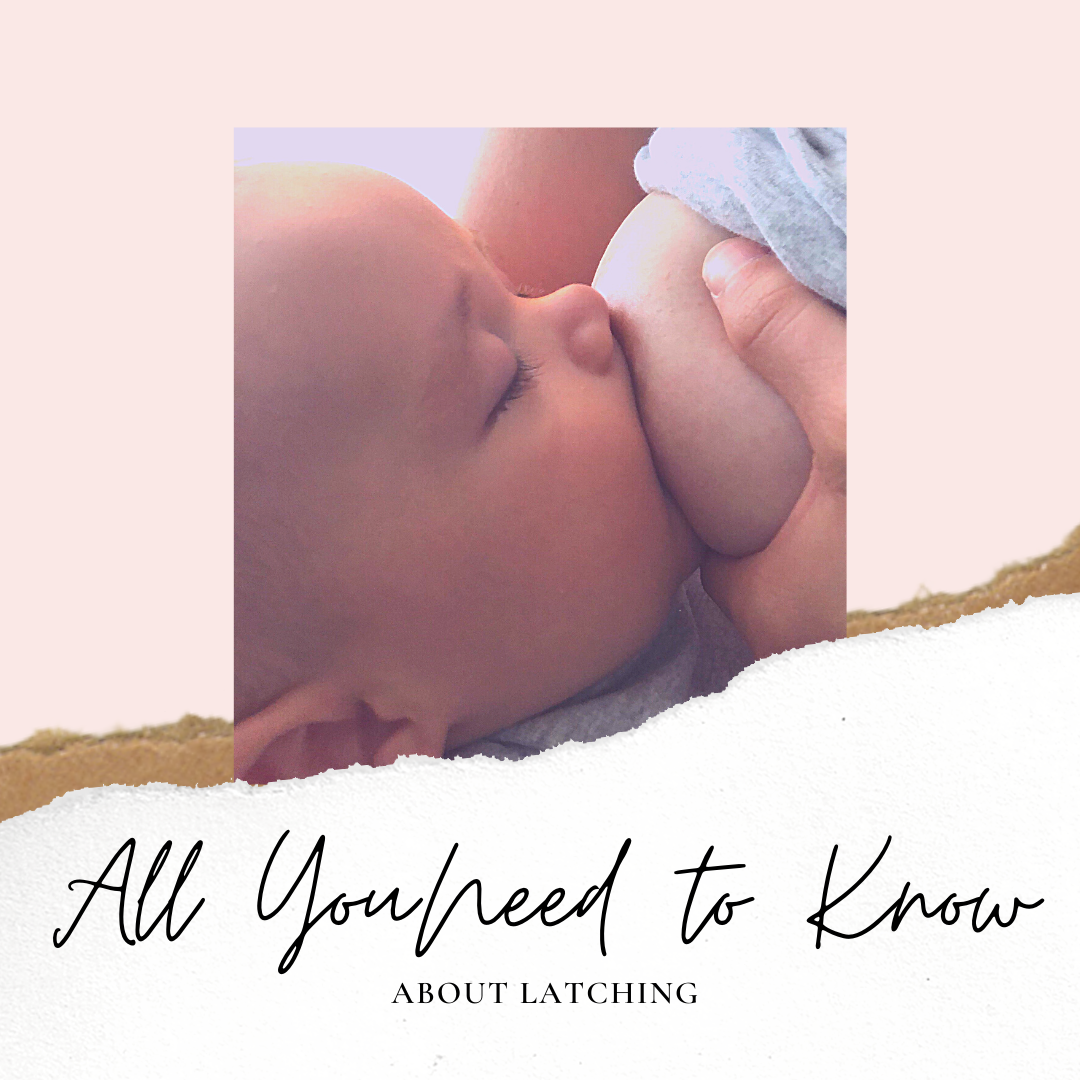Everything You Need to Know About Latching for a Better Breastfeeding Experience
Mommy Care Team
Latching Might Sound Simple, But Moms and Babies May Still Struggle with It.
The truth about breastfeeding is that it’s not always easy. Yes, some moms will be able to do it from day one, but others will struggle. Every mom’s breasts are unique. Our breasts are different shapes and sizes. Some nipples are better suited for nursing, while others are inverted or elastic. Having difficulty nursing doesn’t make you any less of a mom. In fact, it’s perfectly normal. It just means moms might have to try a few different techniques to find a way that works between mama and baby.
While we aren’t lactation experts, we are a team of experienced moms looking to support your lactation journey. Think of us as a knowledgeable friend trying to help moms troubleshoot their breastfeeding issues So, let’s start at the beginning: The latch.
What is latching?
What is a latch? How do you get your baby to latch properly? How do you know if your baby is latched properly?
A latch is the seal created by your baby’s lips around your nipple and areola. While it might sound as simple as putting your baby to your breast, it can involve a little more than that. Birth is a traumatic experience for your baby, and the initial latch will be the baby's first attempt at using his or her mouth to eat.
Latching is a team effort. Mom and baby work together to make suckling happen. Many assume that babies are born knowing instinctively how to breastfeed. In reality, your baby is born with reflexes like suckling. Babies need a bit of help to get the hang of breastfeeding.
Mom, when you are ready to breastfeed, it's important to be comfortable and have lots of pillows on hand. You’ll position these pillows around your tummy and under your arms to help support your baby and free up one of your hands to help facilitate the latch.
Why is latching so important?
Without a good seal around your nipple and areola, your baby will not be able to suckle. In order to breastfeed, you need to get off to a good start, a proper latch. As we said before, birth has everyone a bit tired, and stressed, so a good latch might not happen on the first try. In this post, we put together some tips to get you started, but we also highly recommend seeking the advice and guidance of a International Board Certified Lactation Consultant or IBCLC.

Getting a good latch will help to protect mom’s nipples, areolas, and/or breasts from irritation, sores, and bruises.
Is there a right way and a wrong way?
IBCLCs are available within most hospital systems and can visit you once your new baby has arrived. These consultants are highly trained professionals who have an array of techniques to help your baby latch. We’ll go over this at a high level here in this post, but we cannot recommend enough how you should make time to see a lactation specialist during your hospital stay.
A proper or healthy latch is when your baby’s lips form a seal around your nipple, drawing about a half an inch of your nipple and areola into his or her mouth.

Your nipples grew darker in color over the course of your pregnancy to help your baby find them, but in the early days of life you will need to help guide your baby.
Your baby’s nose will be very close to your breast, so close it’s almost touching. You might worry that it’s too close but if your baby can’t breathe they can’t eat. If they’re suckling, they’re able to breathe. Some say that their nose will or should be the width of a credit card from your skin.

How to get baby to latch
To get a proper latch, start by holding your baby close to your breast. Cupping your breast with your hand, gently stimulate your baby’s bottom lip by rubbing your nipple against it. When he or she opens their mouth wide, bring your baby’s head to your breast. You’ll have to be quick or you’ll miss the opportunity. Don’t worry, just repeat the first few steps and try again. Don’t stress out if you don’t get it the first time. If you try to stay relaxed, breastfeeding will be easier for you and baby.

Another way to stimulate your baby’s suckling reflex is to use your pinky finger in place of your nipple. Gently insert the first half inch of your pinky, bottom side up, into your baby’s mouth. They’ll start sucking. After they get the hang of it, you can repeat this but with your breast instead of your pinky. This is also a great opportunity to get your partner involved in feeding your baby from the very start. Most will be impressed by how strong the baby can suckle right from the start!

If you don’t get a proper latch, take your pinky finger and gently work it between your skin and your baby’s lips to break the seal.
Once they have latched, your baby will begin to suck which will stimulate your let down. When your baby begins to swallow, you will see their jaw moving back below their ears, their temples will wiggle, and you can sometimes hear a whispered “keh” or “K-AH” sound.
Signs You Need to Try again:
If you hear a clicking noise it might mean that the baby is not latched properly. If your baby is turning read or growing fussy they are not getting milk. Instead they might be latched in the wrong place. These signs could also mean they are not getting a proper seal which means they are getting air rather than milk. Rooting, or hunting around with their nose and mouth is something your baby will do when they are hungry. If they are rooting while you are trying to breastfeed or nurse, this might indicate that they are having trouble.
If your babies lips are curled, as in the picture below, or not forming a seal against your breast, break the latch and try again.
Poor Positioning:
If you are not able to hold your baby comfortably in a certain position it can affect your baby’s ability to latch. Be sure to get comfortable, grab lots of pillows or a nursing pillow, and try to find a position that enables you to hold your baby in the proper position: supported, close to your breast, and lined up to your nipple and areola.

Alignment:
While this might change later on, when you first start trying to latch make sure that your baby’s head and neck are aligned. A “football” style hold is a great way to help achieve this alignment. Lay the baby on your forearm, and place your hand under his or neck to cradle and align their head. This will enable your baby to focus solely on the task at hand while feeling safe and secure. For more information on the football and other breastfeeding positions, click here.

Missing the Target
If your baby is eager to eat, they may latch onto anything they can find. This means that they might not be properly aligned to latch onto your nipple and areola. Getting them properly aligned before bringing them close to your breast can help them find their target and get a proper latch.

A Lack of Milk:
If there is no milk available, your baby won’t be able to eat. This means they won’t latch. Don’t freak out. Babies can come up to two weeks early before they are considered premature, so some moms will find that their milk has not yet come in. An IBCLC can help to troubleshoot this with you by hand expressing colostrum and talk about how to encourage milk production.

Nipples Come in Different Shapes and Sizes:
Every mom’s body is unique, right down to her nipples. Some nipples make latching more difficult but not impossible. Some nipples can be flat, others inverted, and others still are elastic.
What If Baby Latches, but Can’t Feed?
There are a lot of moving parts when you first start breastfeeding, so be gentle with yourself and with your baby. Not only is baby learning how to latch, but he or she is also what to do with their tongue. Some IBCLCs or labor and delivery nurses will offer a nipple shield to help draw the nipple into the baby’s mouth and position it so that they can suckle. If this is offered, give it a try, knowing that this is just the beginning and doesn’t necessarily mean that you will have to continue using the nipple shield to nurse.
How Can A Baby Eat If They Can’t Latch?
There are many benefits to seeing an IBCLC while in the hospital. If you are having trouble breastfeeding, these specialists can help teach you a variety of techniques, including hand expressing your colostrum to feed your baby via a syringe or dropper. They can also offer hospital breast pumps and show you how to use one to express your milk.
The Moral of the Story
Be patient, keep trying, and be kind to yourself. It might take a day or two, and different methods but one way or another you’ll find a way that works. Not all moms nurse. There are a number of moms who use breast pumps to express their milk and then bottle feed their baby. That’s why we’re here! BeauGen helps moms comfortably use their breast pump without pain. It's our mission to help moms across the world feed their babies without stress, pain, or worry. Curious about our breast pump cushions? Learn more here and try a pair for yourself.

